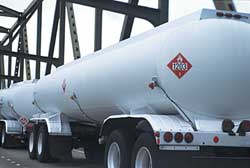Hazardous Waste's New Manifest Destiny

It's 10:00 p.m. Do you know where your hazardous waste is? Unlike your teenage kids who might be impossible to keep track of once they leave the house, the hazardous waste generated at your facility and shipped off-site can be traced easily at all times thanks to the Hazardous Waste Manifest System.
This system is a set of forms, reports and procedures designed to keep affected parties apprised of the whereabouts of hazardous waste from the time it leaves the generator facility where it was produced, until it reaches the off-site waste management facility that will either store, treat or dispose of it. Under the Resource Conservation and Recovery Act, manifests are required for transporting almost all hazardous waste.
Currently, the manifest is a paper document containing multiple copies of a single form. When completed, the document contains information on the type and quantity of the waste being transported, instructions for handling the waste and signature lines for all parties involved in the disposal process. Both the U.S. Environmental Protection Agency (EPA) and the U.S. Department of Transportation (DOT) require manifests. All parties that handle the hazardous waste sign the manifest and retain copies for themselves. This procedure ensures accountability in the transportation and disposal processes. Once the waste reaches its destination, the receiving facility returns a signed copy of the manifest to the generator confirming that the waste has been received by the designated facility.
For quite some time, generators and transporters have criticized EPA's manifest process as being too cumbersome. In response, EPA officials have worked on developing a less paper-intensive manifest process. According to EPA officials, state regulators alone spend about 200,000 hours a year processing hazardous manifest forms. Another complaint from the regulated community is that more than 20 states mandate that involved parties provide them information in addition to the federal manifest requirements.
In an effort to lighten this paperwork burden, EPA officials have made proposed changes to streamline the Uniform Hazardous Waste Manifest regulations with the hope that the revisions will result in a 25 percent work reduction for hazardous waste handlers. On May 22, 2001, the proposed regulatory changes were published in the Federal Register (66 Fed. Reg. 28, 240). Written comments on the proposed regulation were due before August 20, 2001. To view the proposed regulation, go to www.epa.gov/epaoswer/hazwaste/gener/manifest/index.htm. At press time, EPA had not published the final version of the regulatory revisions.
In the new rule, EPA proposes three major revisions to the manifest system. First, the agency proposes to further standardize the content and appearance of the current manifest form and to make the form available from a greater number of sources. Second, EPA seeks to promote manifest tracking procedures for the follow-up manifesting of hazardous waste loads rejected by treatment, storage and disposal facilities. Last, EPA proposes giving waste handlers required to use the form the option to complete, send and store manifest information electronically.
"In terms of cost reductions, EPA projects that manifest automation could produce between $14.4 million and $26.6 million in cost savings to waste handlers," EPA officials stated in the proposed rule's preamble.
EPA is to be commended for finally taking steps to update the manifest system. Automating the manifest system should save time and money for both the regulators and the regulated community. Additionally, it will make it easier to track hazardous waste shipments and thereby more effectively protect the environment.
Revised Rx for Transporting Medical Waste
On January 22, 2001, DOT proposed changes to the rules governing the transportation requirements for infectious substances, regulated medical waste, diagnostic specimens and genetically modified organisms. The docket number is RSPA-98-3971, but it is better known as HM-226. The proposed revisions can be viewed at hazmat.dot.gov/rulemake.htm#nprm. The comment period on this proposed revision ended April 23, 2001. At press time, EPA had not published the final version of the regulatory revisions.
The proposed changes could be significant for waste disposal facilities and the health care industry. One important revision concerns how to characterize medical waste in order to determine proper handling and packaging procedures. DOT plans to use the World Health Organization's (WHO) risk groups instead of the existing U.S. Center for Disease Control's (CDC) biosafety levels. The intent is to update the U.S. regulations to match international standards. However, some groups such as the National Solid Wastes Management Association's Medical Waste Institute (MWI) are criticizing these proposed regulatory changes. For example, MWI argues that DOT has failed to provide comprehensive and understandable information about the WHO risk groups that will allow the U.S. regulated community to comply with these changes. It's a sure bet that these proposed regulatory revisions will provoke further controversy if adopted.
This article originally appeared in the September 2001 issue of Environmental Protection, Vol. 12, No. 9, p. 6.
This article originally appeared in the 09/01/2001 issue of Environmental Protection.